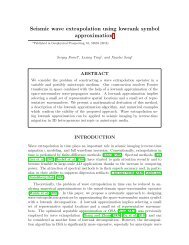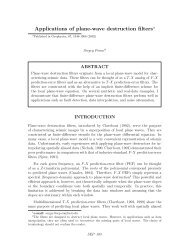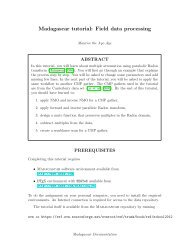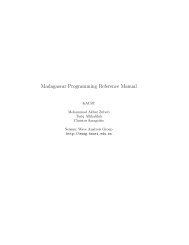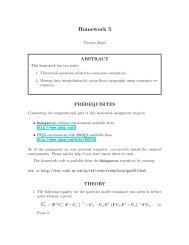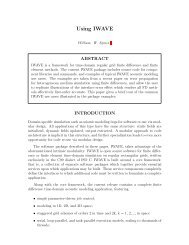Modeling 3-D anisotropic fractal mediaa
Modeling 3-D anisotropic fractal mediaa
Modeling 3-D anisotropic fractal mediaa
Create successful ePaper yourself
Turn your PDF publications into a flip-book with our unique Google optimized e-Paper software.
Chemingui 9 Fractal media<br />
indicated by the steepening in the slope of the autocorrelation.<br />
Figure 6: Synthetic continuous random field with apparent layering and Gaussian<br />
autocorrelation; a x = 5, a y = 80, a z = 80.<br />
CONCLUSIONS<br />
In this initial study I have tackled the forward problem for modeling <strong>anisotropic</strong><br />
<strong>fractal</strong> media using second-order statistics. The method has close analogy with the<br />
two-dimensional Goff and Jordan model for seafloor morphology. The generation of<br />
synthetic models is done in the Fourier domain and the algorithms are similar for the<br />
one- two- and three-dimensional problems. The von Karman functions are presented<br />
as a generalization of the exponential correlation function associated with the Markov<br />
process in modeling seismic impedances. The von Karman functions can be used for<br />
better description of statistic lithology of stratigraphic columns and understanding<br />
their depositional pattern. I have also computed a two-state model (i.e., rock/pore<br />
or sandstone/shale) by mapping the random field from continuous realizations into<br />
a binary field. Comparisons of the autocorrelation functions of the continuous and<br />
binary fields show that the <strong>fractal</strong> dimension (i.e, the roughness of the medium)<br />
increases through the “binarization” process.<br />
FUTURE WORK<br />
Future goals of this effort will be to formulate the inverse problem for estimating<br />
the characteristic parameters of the <strong>anisotropic</strong> <strong>fractal</strong> medium, i.e, aspect ratios of<br />
anisotropy, and Hausdorff (<strong>fractal</strong>) dimension. The technique of deriving the binary<br />
SEP–80




